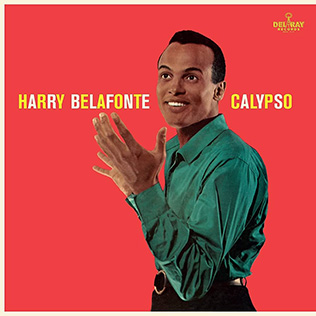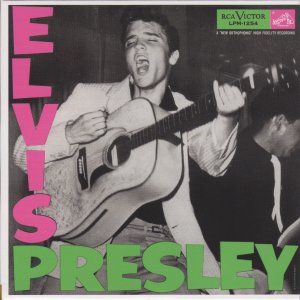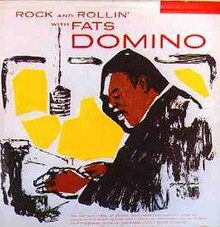
Brad's Take:
The first time I remember hearing Bill Haley's song "Rock Around The Clock" was while listening to my parents copy of the American Graffiti movie soundtrack. It's a 2-disc compilation of songs from the 50's and 60's. I remember it being one of the first times I realized that I loved "oldies music." I think the only songs from this album that I had heard before though are the first tracks ("Rock Around The Clock" and "Shake, Rattle, and Roll.")
The overall recording of this album is a lot different than the
Fats Domino album we reviewed before this one. It's mixed a lot better and the band plays tighter than Domino's. It still has a very live feel to it, however. It's not overly polished by any means.
This is a fun mid-50's collection of songs that I'm sure made the kids want to get up and "shake, rattle, and roll" (pun intended!) I even found myself tapping my foot and bobbing my head side to side. Each song has an upbeat tempo. There's no slow songs on this album. High schoolers were probably either bummed out by the fact that there were no songs to slow dance to with their dates, or they were stoked that they could put this album on and just have fun all night with their friends. I like to think that it was probably the latter.
A lot of the songs sound similar on this album, but I think back then, it wasn't about bands trying to write a collection of different sounding songs. They stuck to the formula that worked for them, and they perfected it. They didn't change their style or experiment much until later in their careers, if at all. It's kind of hard for me to imagine, but I assume rock and roll was still so fresh and new at this time that kids and teenagers weren't bored of the blues/rock sound yet. But really, how could anyone be bored while listening to this?
Dad's Take
Where Fats Domino showed the influence New Orleans blues had on the fledgling rock'n'roll, Bill Haley and his Comets showed the swinging side of the new fad in popular music.
To earn a few more bucks off the fad while it lasted, DJ Alan Freed and the movie company rushed out a string of low budget movies featuring the awful music those wacky kids were listening to, with its devil beat and "colored" influence. These movies had a thin plot, usually about Alan Freed putting on a show for the kids, but the story didn't matter. This was a way for Freed to show off his stable of artists and to get the kids to let loose of their quarters for a movie seat.
I think Rock Around The Clock was the first of this string of films. No soundtrack was ever released, but Bill Haley and his Comets, the headline act in the film, put out their album to capitalize on the album. Strangely, the title song, although heard three times in the movie, was never actually performed on stage during the rock 'n' roll show. The song the kids went to hear was never performed. It's too bad no soundtrack was ever released because it featured some great performances by Haley's combo and other great and not-so-great bands, most notably the Platters.
As Brad said, this album is nothing but fun. It was meant to be dropped onto a hi-fi at a platter party and danced to. Fats Domino's music was great for the stroll, but this is pure jitterbug music from the moment the needle hits the wax.
Now you can listen to it as a cultural artifact, and boogie with your baby while you do it. There's the classic title song, followed by Haley's sanitized, radio-friendly version of
Big Joe Turner's "Shake, Rattle, and Roll." Also included is a Cold War artifact, where Haley dreams that his town was destroyed by an H-bomb, leaving only him and thirteen women alive. The women are, of course, there for his pleasure.
What strikes me about many of the songs--mostly performed in classic swing style with a big band replaced by a tight combo of guitar, bass, piano, and sax--is how much filler was added to the two hits, and how as long as the song says "rock," "roll," and "boogie" enough times, it's rock 'n' roll and not swing.
Check out this song, the album's closer:
Rock, rock, rock, everybody,
Roll, roll, roll, everybody,
Rock a beating boogie beat.
You take a rock, you take a beat,
You take a boogie, you make it sweet,
You take a rock a beating boogie,
Rock a beating boogie beat,
Well, rock a beating boogie,
B-O-O-G-I-E.
Well, we’re rocking to the rhythm,
Of the rock a beating boogie,
Dancing to the rhythm,
Of the rock a beating boogie,
Shaking to the rhythm,
Of the rock a beating boogie,
Jumping to the rhythm,
Of the rock a beating boogie,
Romping to the rhythm,
Of the rock a beating boogie,
B-O-O-G-I-E.
You gotta jump, you gotta jive,
You gotta dance to be alive,
You take a rock a beating boogie,
Rock a beating boogie beat,
Well, rock a beating boogie,
B-O-O-G-I-E.
But the dorky-but-cool jive lyrics didn't matter. What mattered was the beat. And the beat never lets up throughout this whole record, providing the perfect platter for your platter party. It's pure fun, and it changed the world.
You really can't beat that boogie beat. Put it on and try to remember that there was a time when this sound was brand new and exciting, and created a musical generation gap that has never been bridged. Most of all, though, just have fun. It's really hard not to with music this infectious.










